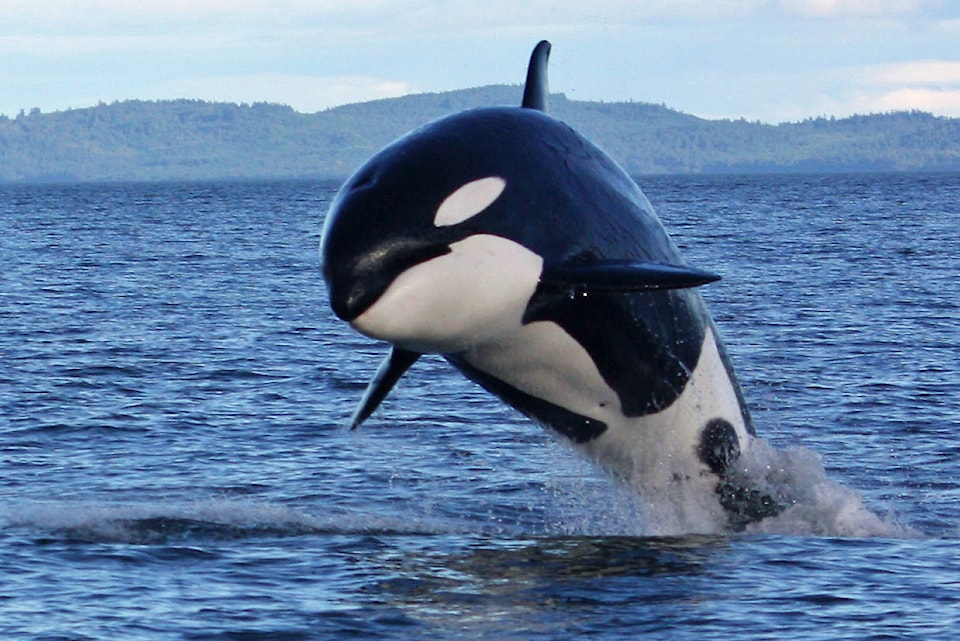It’s a rich fishing ground for salmon trollers, sport fishers and threatened northern resident killer whales.
Based on recent whale-sighting surveys and underwater call recordings, scientists say the waters between Langara Island and a point about 13 km north of Rose Spit are critical habitat for the Chinook-loving orcas, especially in winter and spring.
“There is no other known area within the range of the population that is frequented as often, and as regularly, by northern resident killer whale groups as western Dixon Entrance,” says a DFO science advisory report published in late 2017.
Stretching north of Graham Island to a depth of about 200 metres, the area excludes Naden Harbour, Masset Inlet and the shallows of Virago Sound and McIntyre Bay, where the northern residents are seen less often.
| A map shows the area north of Haida Gwaii that Fisheries and Oceans Canada is looking to designate as a critical habitat for the recovery of northern resident killer whales. Note that the map mislabels Naden Harbour as Masset Inlet. (Fisheries and Oceans Canada) |
Given the findings, DFO and Parks Canada are now seeking public feedback on an updated recovery plan for the threatened northern residents and their endangered cousins to the south — a plan that would make the 1,394 km2 area north of Haida Gwaii one of just four designated critical habitats for resident orcas in B.C.
Johnstone Strait, off northeastern Vancouver Island, is already protected as the fall and summer hotspot for northern residents, though many of the 16 northern resident pods seem to stay mostly around Haida Gwaii.
Likewise, an area wrapping southwest Vancouver Island is designated as the key fall and summer habitat for southern resident killer whales, and it continues into U.S. waters.
Besides the Haida Gwaii area, the updated plan would add a fourth area of critical habitat off southeast Vancouver Island where pods of both northern and southern resident killer whales seem to feed year-round.
Sport fishers concerned
While the proposed DFO plan says there are no immediate plans for fishery closures in the newly-identified habitats, sport fishing groups say they are profoundly concerned.
Gerry Kristianson, chair of B.C.’s Sport Fishing Advisory Board, wrote a letter to Fisheries Minister Dominic LeBlanc last week saying a 30-day comment period that ended last week and a 60-day comment period that starts in August are too short and poorly timed with the fishing season in high gear.
Kristianson also questioned whether scientists have surveyed enough of the B.C. coast to be sure the newly identified Haida Gwaii area and the one off southeast Vancouver Island are really exceptional habitats.
“In fact, anglers have observed whales travelling and foraging on the west side of Haida Gwaii, which shows the need for further research before accepting the proposed designation,” Kristianson wrote, before pointing out that other recent studies suggest links between Chinook declines and the effluent from Vancouver’s largest sewage plants.
In Masset, home to fishing lodges, chartered fishing companies, an airport buzzing with summer sport fishers, and several businesses serving the lodges at Naden Harbour and Langara Island, village councillors also expressed concern.
“We need more time to actually go through this,” said Mayor Andrew Merilees, who got a copy of the 94-page recovery plan shortly before last week’s council meeting and two days before the end of DFO’s first comment period.
“It’s something I think we should review, and put forward a thoughtful response to.”
Councillor Bret Johnson, who runs a small fishing lodge, said if DFO gets to the point of shutting down fishing from Langara to Rose Spit to save the whales, it should take equally drastic measures elsewhere.
“I think if they want to do that, then they should also shut down the Port of Prince Rupert, the Port of Vancouver, and nobody in Victoria can flush their damn toilet because the sewage goes into the water,” Johnson said.
Southern residents worse off
According to Fisheries and Oceans Canada, designating an area as critical habitat for at-risk species does not mean automatic fisheries closures.
The goal is to protect the habitat, whether from overfishing, pollution, or excessive noise from ships, industry, and sonar.
In a related move, on July 11 new federal rules came into force requiring all boaters to stay at least 200 metres away from killer whales in B.C. waters, and 100 metres from most other whales, dolphins, and porpoises.
Penalties can range from $100,000 to $500,00, and DFO has said it will increase enforcement patrols on water and by air, though no details have been provided.
Northern resident killer whales range from Glacier Bay, Alaska down to the coast of Washington.
As of last year, DFO counted 309, including 10 calves — a population more than double the 120 recorded in the 1970s when the DFO surveys began.
But the northern residents’ otherwise steady recovery did have a downturn in the late 1990s, during years of low Chinook returns. They remain a “threatened” species under Canada’s Species at Risk Act.
Meanwhile, southern resident killer whales numbered just 75 at last count, a 30-year low, and no calves have been born in the last three years.
The southern resident population does not mix with the northern residents and is showing signs of inbreeding. Southern-resident females are also calving only about once a decade instead of the usual five years.
In the latest science advisory report to DFO on resident killer whales, researchers cautioned that most sampling for killer whale prey has been done in summer and fall, so it may be that they target fish other than Chinook in winter.
Scientists are also unsure what density of Chinook is needed to make a habitat into a “hotspot,” or what threshold of human-made ocean noise is likely to hurt the whales’ chance of recovery.
A copy of the updated recovery plan for northern and southern resident killer whales is available on the DFO website.
andrew.hudson@haidagwaiiobserver.com
Like us on Facebook and follow us on Twitter
